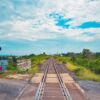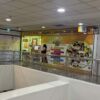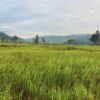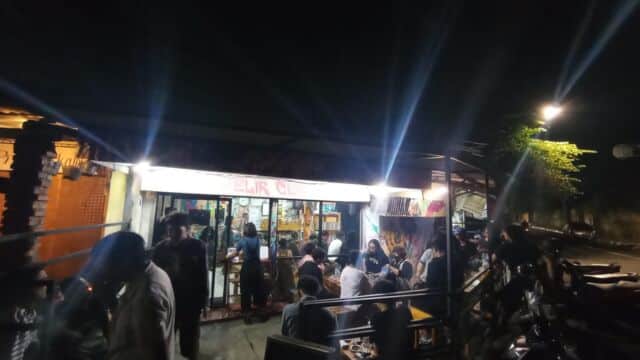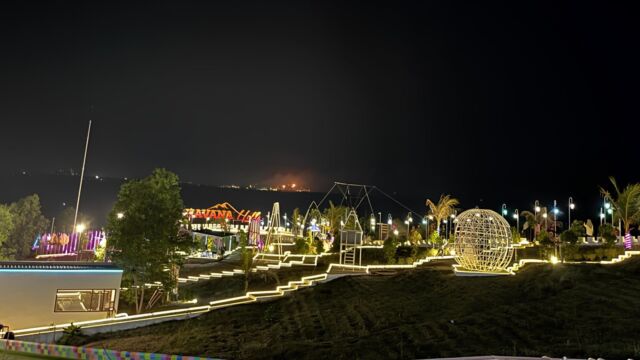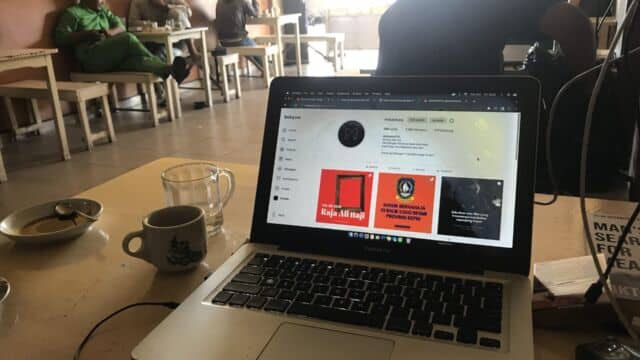The Unconventional Majesty of Mount Sunda
Photo: Pradipta Dirgantara
Mount Sunda | 2,000 words | Translated from Bahasa Indonesia by Dan Benjamin
Mount Sunda is not a popular mountain for hikers. It’s not like Mount Ceremai, the highest peak in West Java, or Mount Papandayan, which has a reputation as a good mountain for trekking beginners. There’s not much information about Mount Sunda on the internet. But this was part of the reason we chose to hike it: we wanted to avoid a ‘commercialized’ mountain visited by lots of tourism-focussed people. Also, Mount Sunda’s not too far from the city of Bandung, where we all live.
From the middle of Bandung, the foothills of Sunda can be reached in about two hours by car or motorbike. Myself and five others, Tedi, Dimas, Brian, Cecep and Anugrah, departed on four motorbikes, with me, Tedi, Dimas and Brian each driving our own bikes and Anugrah hitching a ride on the back of Cecep’s.
Hiking is a social ritual for Tedi, Dimas and I. At least once a year the three of us go off together, either up a mountain or just somewhere into nature to contemplate. Tedi and Dimas I’ve known since middle-school: we’ve now been friends over 15 years. Tedi works as a geologist and Dimas a machine technician, while I’m a lecturer in Environmental Communication.
Brian and Anugrah, meanwhile, are work friends of Tedi, and Cecep is Tedi’s cousin. All three are land surveyors. Because they all also share the same hobby of and interest in the natural world, even though this was my first time meeting Brian, Cecep and Anugrah, we got on fine, with no awkwardness at all.
Luckily, Brian – whom we called Abah Anom, meaning ‘Young Father’ in the Sundanese language – is originally from the area around Mount Sunda. Turned out, too, that he has a side-gig as an orchid farmer, and maintains an orchid nursery a mere seven kilometres from the mountain’s foothills.
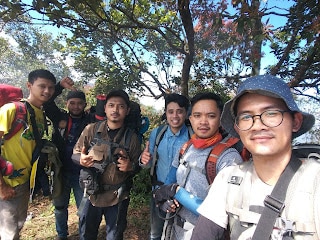
Don’t imagine there’s a basecamp at Mount Sunda like there is in the commercialized mountains: on arriving, we found only three or four small warung restaurants catering to farm workers and local residents. Nonetheless, those warung owners were very friendly towards us. One let us park our motorbikes in the yard out the back of his warung. Next to the warungs were several saungs, open wooden huts, for customers to relax in. We sat in one for a bit, ordering coffee and instant noodles. Then we started to move, following a narrow trail that appeared just beyond the line of eateries, on the right side of the road. The trek had begun.
I heard the babbling rippling noise of a stream, then as we walked across a wooden bridge I looked down and saw its clear water. During the first 30 minutes of the walk, the path was flat, and we were surrounded by the small farms of locals, planted with tubers. Soon the hiking track started to slant uphill, with the ground loose and soft. We grew busy trying to control our breath, each step forward feeling increasingly heavy.
When we took our first break, a discussion started up.
Tedi said: ‘Most people think geology is just about the earth. But it’s far more than that. From geology we can know the physical condition of nature in the place where we live, find out the extent of environmental destruction, predict disasters, even come to know about previous civilizations’.
A bit later Abah Anom said: ‘Bandung and the area around it have a lot of potential for tourism because of the craters and lakes. I really like acting as a tour guide for guests from outside Bandung who want to do trekking in terrain like that’.
A bit later I offered: ‘It really is true that, to care about the environment, people need to know it first. And to know it, we need to experience it first hand, to come out here into nature. Our mountains, our rainforests, our nature, apart from being exploited – we know that – they also get stigmatized in our horror films. Maybe that’s what makes so many people reluctant to come out here.’
As I talked I saw Anugrah and Cecap listening while attempting to bring their breathing back under control after the climb.
‘And so all these environmental issues, there’s no end to them in Indonesia’, I added, starting to get a bit fiery. ‘But we’re the number three nation in the world in terms of the size of our tropical rainforests, one of the richest nations in biodiversity!’
Dimas then ended this discussion by saying, in Sundanese: ‘What is this, a college lecture?’
As the hike got steeper, the six of us became out of breath again and again: we started taking breaks more often, getting out our drinks and snacks for energy. Now there was no more talk, just the sound of our breath, plus loud gulps and chews.
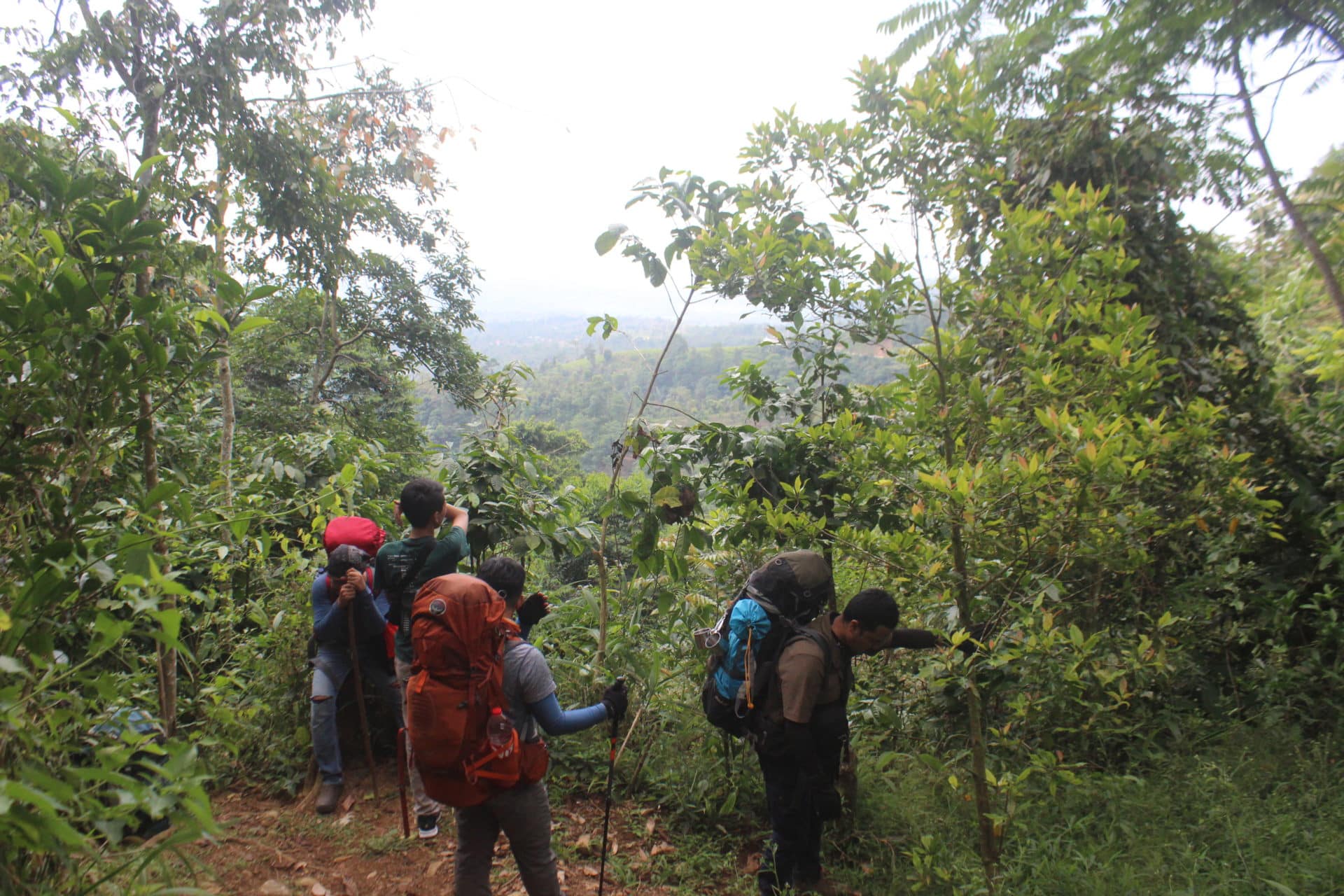
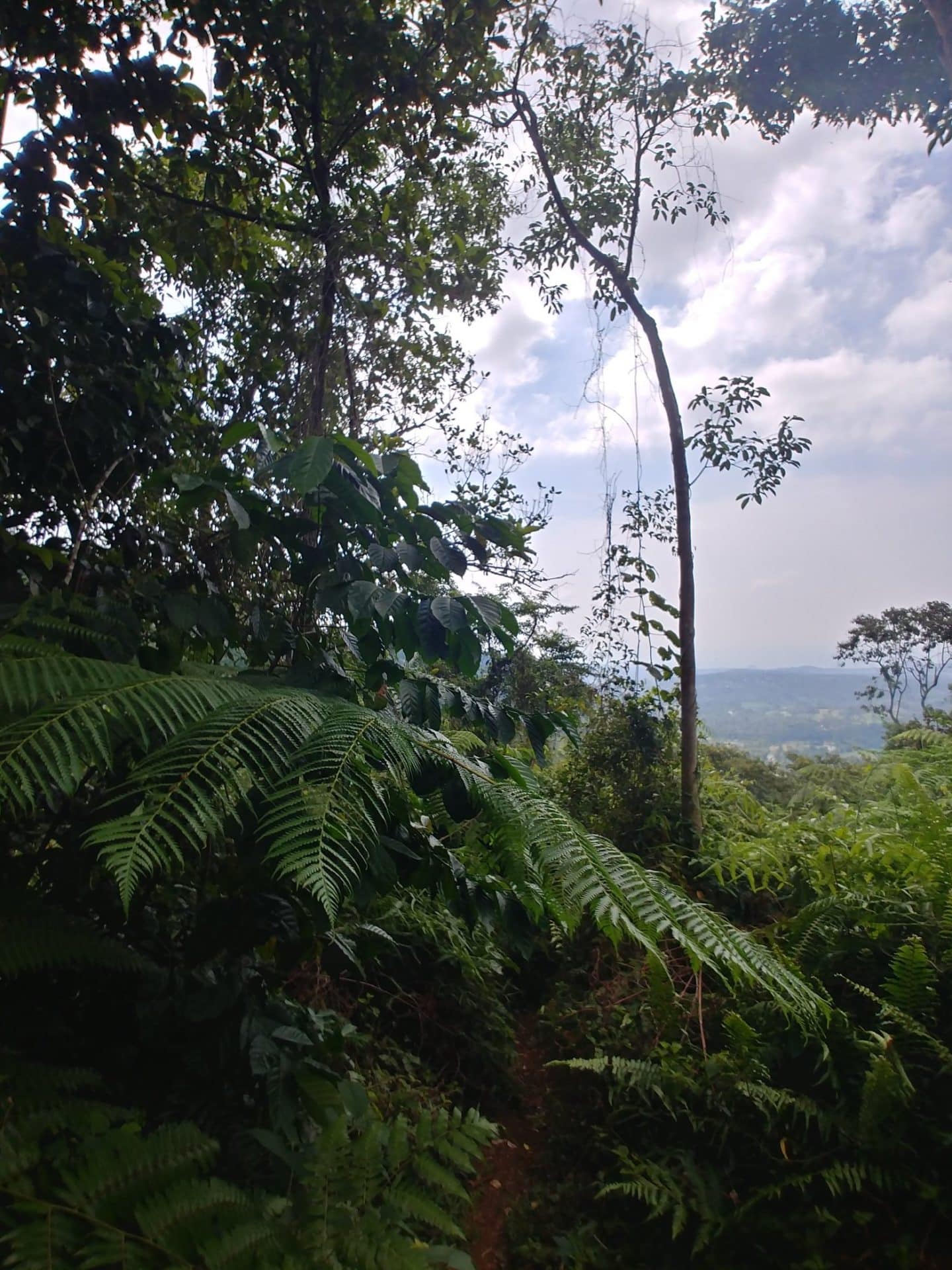
Because it’s not a commercialized mountain, Mount Sunda doesn’t have hiking markers, permanent hiking shelters, or often even a clear hiking path. The trail got extremely narrow several times, and there were also lots of forks that could easily have gotten us lost. I very much recommend that people hike Mount Sunda with someone who already knows the way.
Ahead of three o’clock, we arrived in an open area beside a cliff. In this area there was a makeshift settlement consisting of several provisional wooden huts – like a hidden village. Large pine and teak trees towered over those huts, while a small stream, different to the larger river at the start of the hike, flowed sedately.
When we again stopped momentarily to catch our breath and rest our legs, I greeted several youths who were cooking instant noodles.
‘Excuse us – just passing through’, I said.
‘No problem’.
‘You guys just get here, or been here awhile?’
‘Some just arrived. Me and my friends, though, we’ve been here a few days. We want to niis’.
This was said by the person who, it seemed to me, was the oldest of them. He answered me while stirring his instant noodles, cooking in a small pot.
‘We’ll eat’.
‘Of course: go ahead’.
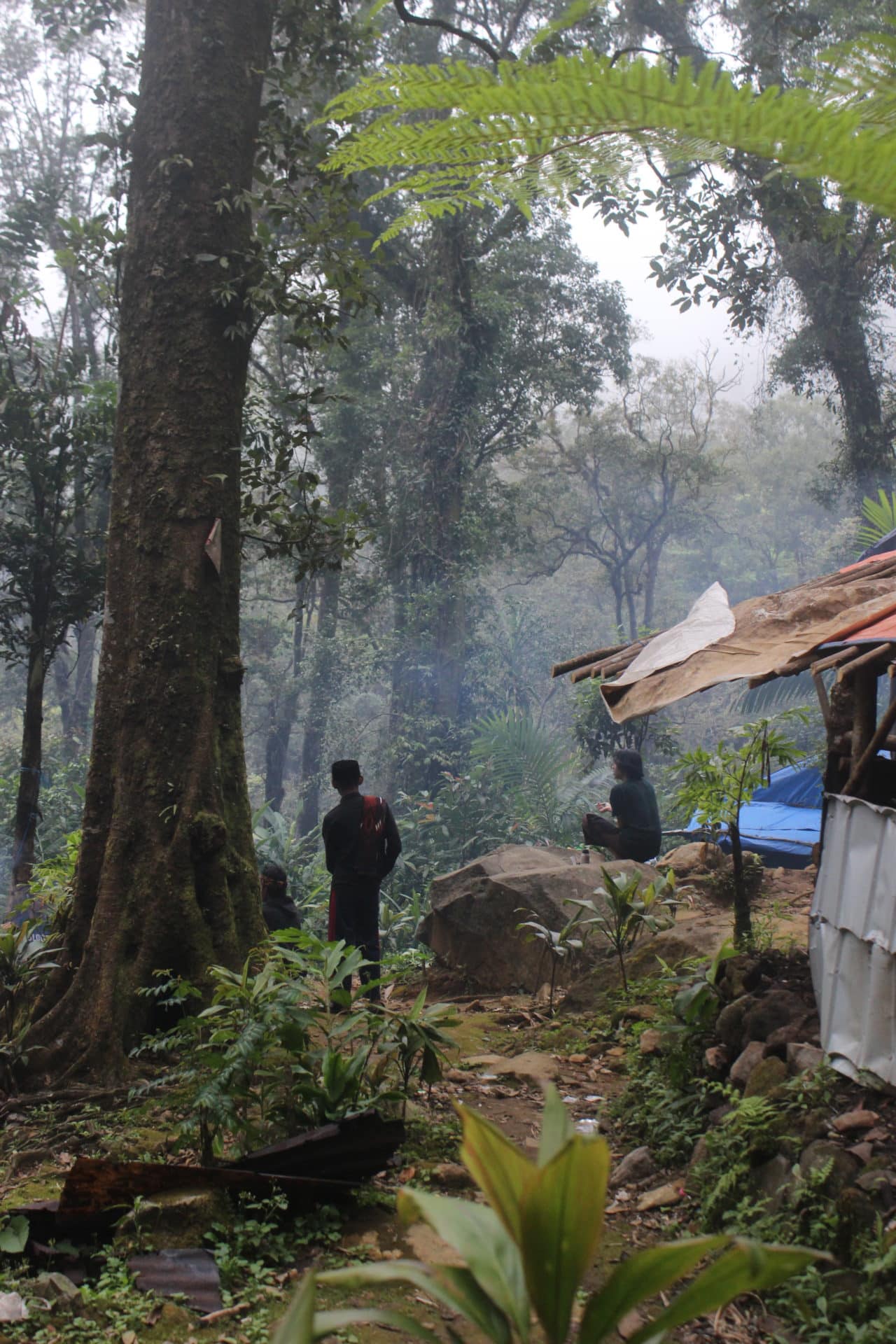
It was already obvious to me they weren’t hikers, because they didn’t have big packs like us. They only wore sarongs, and their stuff had been brought up in plastic bags. It occurred to me only now that, the whole day so far, we’d met no other hikers like ourselves. Instead, most people who go to Mount Sunda are wanting to niis.
In Sundanese, niis is, literally, ‘cool down’. It usually means to search for spiritual tranquillity or to remove one’s self from hustle and bustle, or it can also mean cooling down one’s negative emotions or ego. Mount Sunda is used frequently as a place to do these things. Supposedly, this area is a historic site with lots of stone artefacts, arranged neatly and held sacred by the local people of the slopes. Ahead of Shawwal, the tenth lunar month in the Islamic calendar, many people will come to this mountain and be silent in huts like these as an act of pilgrimage and niis. So it was no surprise to come across this settlement with people staying overnight.
I set down my pack, took out a bottle of drinking water. My friends were also at rest. Abah Anom now went inside one of the huts, and helped himself to a pot. Our plan was to make nasi liwet, a rice dish, on the summit later. After a minute, Abah Anom returned, together with an old man. Abah Anom introduced us all. The old man greeted us and said, while smiling: ‘Don’t forget to pray’. Apparently Abah Anom had known the old man quite a long time, often coming to this place while searching for rainforest orchids. Abah Anom showed great respect to the old man.
I pushed our party to not rest too long. I wanted to get to the peak before Maghrib. But well before the sunset-prayer time it had grown so dark on the mountain that we had to turn on our torches. We were walking beside another creek and, like it or not, my feet, protected only by hiking sandals, sloshed in a watery muddy mix. I was alert for the appearance of leeches, but my preventive efforts failed. Shining my torch on my right ankle, I saw three of them affixed. I murmured: ‘This must be in lieu of an entrance fee, hey’.
When Maghrib came, we were stopped at a large fallen tree that was obstructing the path. We turned off all our lamps and just rested while listening to the sounds of the rainforest: the sighing wind, the calls of birds, and the breathing of the six of us. I heard a bird making a call that was quite loud, but hoarse, and repeating and repeating – ‘kwaaak kwaaak kwaaak’– as if welcoming happily the coming of night. I was able to briefly turn on my torch and shine a light on it, and I think it was a black-crowned night heron. I also saw the silhouette of a flying squirrel, launching itself from one tree to another.
After 30 minutes sitting on top of that fallen tree, we started to walk again. The trail got narrower and narrower, and we were now walking right beside a cliff. Finally, we reached the summit.
Not a soul was there except us. Mount Sunda has an open, narrow peak, long enough to pitch only two tents. At the edge sits a small statue.
That night on the peak of Mount Sunda was wonderful. I could make out the Situ Lembang lake and the city of Bandung, glittering. While waiting for the nasi liwet to cook, we chatted and evaluated our hike. Faces that earlier had been tense were now relaxed and full of laughter.
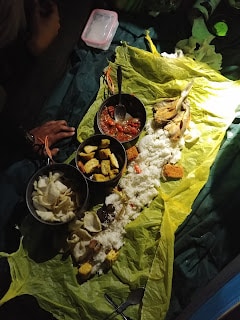
‘I thought Mount Sunda wasn’t so high, and that the path was a normal hiking path’, grumbled Dimas.
‘Abah Anom said we’d go from the bottom of the mountain to the peak in three hours. Turns out it was five. And sucked dry by leeches to boot’.
‘The important thing is that it was fun and that we’re safe, right?’ Abah Anom smiled.
‘The most important thing is: don’t trivialize the mountain. And always prepare for the worst’, said Tedi.
Seemingly in a flash, the nasi liwet was ready. We’d also prepared anchovies, tofu, tempeh, sambal, and prawn crackers. Food on the mountain-top was a balm for our tiredness. If instant noodles is mandatory food to take on a mountain, nasi liwet seemed luxury food.
That night, my friends and I performed our prayers outside the tents. We took what water we needed from our water-bottles for our ablutions. I checked my compass to find the direction of Mecca, then rolled-out the prayer-mat I’d brought. The air wasn’t too cold, remembering Mount Sunda’s not very high. Feeling the night breeze felt like making a friend. Praying in nature, on mountainous ground, with a roof of starry sky, was deeply moving for me. And walking from foothills to a peak feels like a metaphor for life: that together with difficulty is ease, together with struggle is beauty.
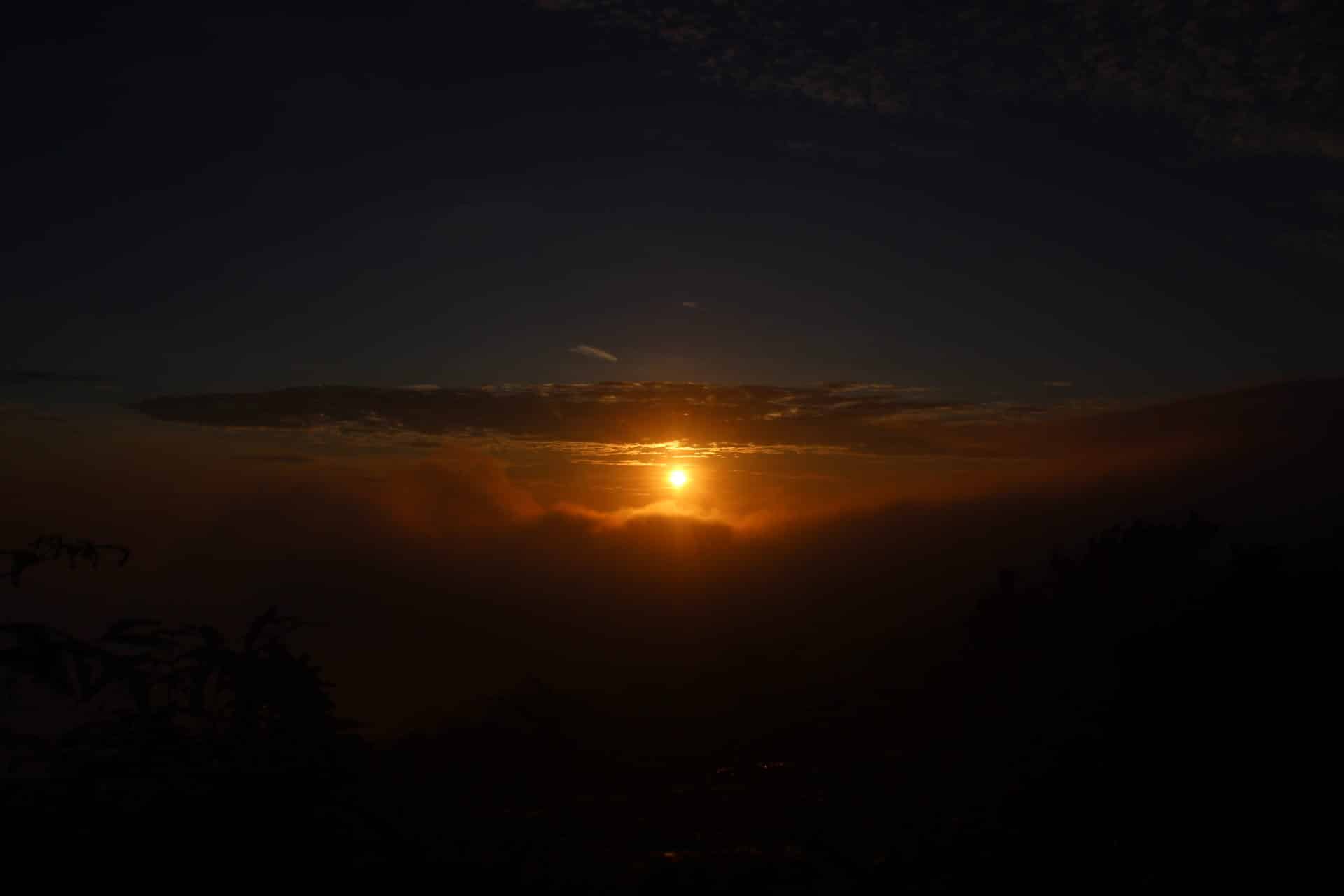
Hours later, ahead of sunrise, I hurriedly rose to await the dawn-prayer and then to witness the sun appear.
That moment of sunrise at Mount Sunda was splendid, magical. All feelings of tiredness vanished when looking at the splendidness of the clouds pooling and massing, the wide sky, and then the sun slowly appearing, full of power. I sat on the edge of the cliff while absorbing the moment. Maybe this was the meaning of niis which those people we had met yesterday were searching for: a spiritual tranquillity, found amidst nature.
© Pradipta Dirgantara
English translation © Dan Benjamin
